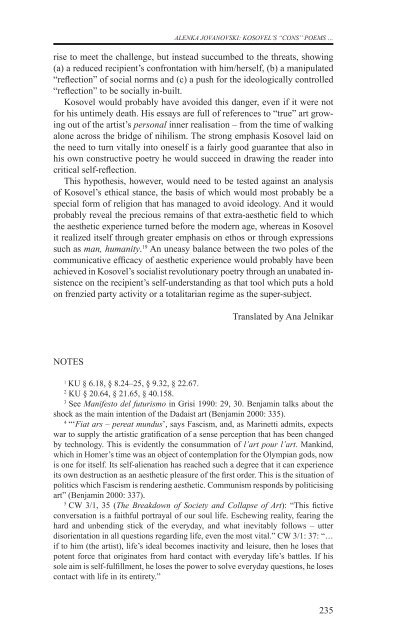razprave (pdf) - Društvo za primerjalno književnost - ZRC SAZU
razprave (pdf) - Društvo za primerjalno književnost - ZRC SAZU
razprave (pdf) - Društvo za primerjalno književnost - ZRC SAZU
- No tags were found...
Create successful ePaper yourself
Turn your PDF publications into a flip-book with our unique Google optimized e-Paper software.
alenka jovanovski: Kosovel’s “Cons” Poems …rise to meet the challenge, but instead succumbed to the threats, showing(a) a reduced recipient’s confrontation with him/herself, (b) a manipulated“reflection” of social norms and (c) a push for the ideologically controlled“reflection” to be socially in-built.Kosovel would probably have avoided this danger, even if it were notfor his untimely death. His essays are full of references to “true” art growingout of the artist’s personal inner realisation – from the time of walkingalone across the bridge of nihilism. The strong emphasis Kosovel laid onthe need to turn vitally into oneself is a fairly good guarantee that also inhis own constructive poetry he would succeed in drawing the reader intocritical self-reflection.This hypothesis, however, would need to be tested against an analysisof Kosovel’s ethical stance, the basis of which would most probably be aspecial form of religion that has managed to avoid ideology. And it wouldprobably reveal the precious remains of that extra-aesthetic field to whichthe aesthetic experience turned before the modern age, whereas in Kosovelit realized itself through greater emphasis on ethos or through expressionssuch as man, humanity. 19 An uneasy balance between the two poles of thecommunicative efficacy of aesthetic experience would probably have beenachieved in Kosovel’s socialist revolutionary poetry through an unabated insistenceon the recipient’s self-understanding as that tool which puts a holdon frenzied party activity or a totalitarian regime as the super-subject.Translated by Ana JelnikarNOTES1KU § 6.18, § 8.24–25, § 9.32, § 22.67.2KU § 20.64, § 21.65, § 40.158.3See Manifesto del futurismo in Grisi 1990: 29, 30. Benjamin talks about theshock as the main intention of the Dadaist art (Benjamin 2000: 335).4“‘Fiat ars – pereat mundus’, says Fascism, and, as Marinetti admits, expectswar to supply the artistic gratification of a sense perception that has been changedby technology. This is evidently the consummation of l’art pour l’art. Mankind,which in Homer’s time was an object of contemplation for the Olympian gods, nowis one for itself. Its self-alienation has reached such a degree that it can experienceits own destruction as an aesthetic pleasure of the first order. This is the situation ofpolitics which Fascism is rendering aesthetic. Communism responds by politicisingart” (Benjamin 2000: 337).5CW 3/1, 35 (The Breakdown of Society and Collapse of Art): “This fictiveconversation is a faithful portrayal of our soul life. Eschewing reality, fearing thehard and unbending stick of the everyday, and what inevitably follows – utterdisorientation in all questions regarding life, even the most vital.” CW 3/1: 37: “…if to him (the artist), life’s ideal becomes inactivity and leisure, then he loses thatpotent force that originates from hard contact with everyday life’s battles. If hissole aim is self-fulfillment, he loses the power to solve everyday questions, he losescontact with life in its entirety.”235
















